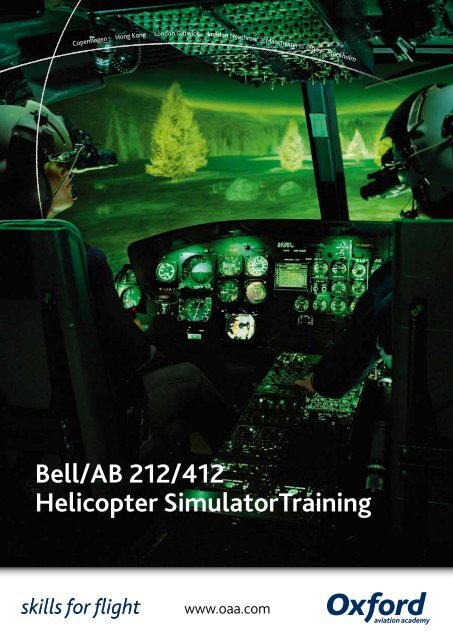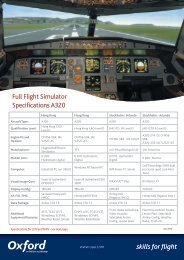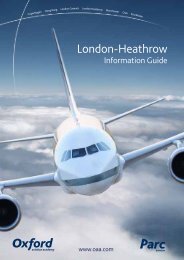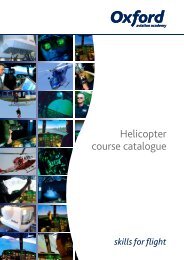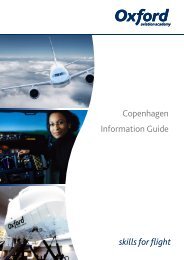Bell/AB 212/412 Helicopter SimulatorTraining - Oxford Aviation ...
Bell/AB 212/412 Helicopter SimulatorTraining - Oxford Aviation ...
Bell/AB 212/412 Helicopter SimulatorTraining - Oxford Aviation ...
You also want an ePaper? Increase the reach of your titles
YUMPU automatically turns print PDFs into web optimized ePapers that Google loves.
Copenhagen • Hong Kong • London Gatwick • London Heathrow • Manchester • Oslo • Stockholm<br />
<strong>Bell</strong>/<strong>AB</strong> <strong>212</strong>/<strong>412</strong><br />
<strong>Helicopter</strong> <strong>SimulatorTraining</strong><br />
www.oaa.com
The benefits of using a helicopter<br />
simulator<br />
There is no doubt that aviation training using simulators offers a cost effective and safe alternative to training<br />
during actual flight. The real cost of helicopter training consists of many variables but includes the hourly costs<br />
associated with fuel, maintenance and insurance. Training in simulators provides a low cost virtually risk-free<br />
alternative allowing pilots to be trained for emergencies and other dangerous real world experiences.<br />
Safety<br />
Historically a large number of serious accidents have<br />
occurred when training in helicopters. Pilots and crew<br />
members have died or become seriously injured and expensive<br />
equipment has been damaged, often beyond repair.<br />
Training in a simulator is totally safe even when practicing<br />
the most severe malfunctions under adverse weather<br />
conditions. Simulation based training allows for the training<br />
of maneuvers or situations that may be impractical (or even<br />
dangerous) to perform in the helicopter, while keeping the<br />
pilot and instructor in a relatively low-risk environment<br />
on the ground. For example, electrical system failures,<br />
instrument failures, hydraulic system failures, engine fires<br />
and even flight control failures can be simulated without risk<br />
to the pilots or helicopter.<br />
Cost effectiveness<br />
Flight simulation provides a significant economic advantage<br />
over training in an actual helicopter. Once fuel, maintenance,<br />
and insurance costs are taken into account, the costs of using<br />
a flight simulator are usually substantially lower than the<br />
operating costs of flying the helicopter for training purposes.<br />
Regulations<br />
JAR-OPS 3.965 and Appendix 1 effectively require training<br />
to be conducted in a simulator if available.<br />
Pilot flying skills<br />
Flight control malfunctions such as loss of control of the tail<br />
rotor, stuck pedals and malfunctions leading to a full down<br />
autorotation can be trained. Many of these malfunctions are<br />
not possible to practice in the helicopter or are considered<br />
unsafe to practice. Instructors can also provide students with<br />
a higher concentration of training tasks in a given period of<br />
time than is usually possible in the helicopter. For example,<br />
conducting multiple instrument approaches in the actual<br />
helicopter may require significant time spent flying the<br />
helicopter to a position where the exercise can begin, while in<br />
a simulation, as soon as one approach has been completed,<br />
the instructor can immediately re -position the simulated<br />
helicopter to an ideal (or less than ideal) location from which<br />
to begin the next approach.<br />
Standardisation<br />
It is important for helicopter operators to ensure that all<br />
crews are trained to the same uniform standard when<br />
confronted by changing weather and operational conditions.<br />
To ensure training is conducted for all crews under the same<br />
conditions the simulator environment can be controlled for<br />
many variable conditions including wind, visibility, daytime<br />
/ night time, cloud ceiling, thunderstorms and outside air<br />
temperature. This ensures that all pilots will be trained and<br />
assessed under the same conditions.
<strong>Helicopter</strong> training at OAA<br />
<strong>Oxford</strong> <strong>Aviation</strong> Academy provides training for both civilian and military customers for VFR, IFR, HEMS, SAR, offshore,<br />
military operations, NVG, CRM and more in our <strong>Bell</strong>/<strong>AB</strong> <strong>212</strong>/<strong>412</strong> Full Flight Simulator.<br />
<strong>Bell</strong>/<strong>AB</strong> <strong>212</strong>/<strong>412</strong><br />
Full Flight Simulator<br />
The simulator is based in Stockholm, Sweden at Arlanda<br />
Airport. It is designed to meet both military and civilian<br />
training requirements for flying skills and mission training,<br />
such as search and rescue, emergency and medical services,<br />
sling load operations and military tactical training. This includes<br />
provisions to train the use of special equipment, such<br />
as weather radar, forward looking infrared and night vision<br />
goggles.<br />
Experienced Instructors<br />
In addition to the simulator, our helicopter instructors play<br />
a vital role in maintaining top quality, reality-based and<br />
realistic training. Most of them are working pilots and have<br />
extensive experience in civilian and military operations<br />
and training.<br />
Advanced Training<br />
We offer Pilot and Technical Recurrent training, CRM and<br />
NVG training, Simulator Operator’s course and Pilot Type<br />
training on the <strong>Bell</strong>/<strong>AB</strong> <strong>212</strong>/<strong>412</strong>.<br />
Additional courses can be designed together with the<br />
customer to address any training need.<br />
Close proximity to the airport<br />
The Stockholm training facility is located at Stockholm-<br />
Arlanda Airport, only a few minutes from the airport<br />
terminals. There are free shuttle buses leaving every 15<br />
minutes in both directions.<br />
At Nightstop, our well equipped hotel directly opposite<br />
the academy, you will find accommodation at competitive<br />
prices.
Testimonial<br />
“We are very pleased with the quality<br />
of the Agusta <strong>Bell</strong> <strong>212</strong>/<strong>412</strong> helicopter<br />
simulator in Stockholm.<br />
The simulator presents our crews<br />
with complex training challenges that<br />
would be too time consuming and<br />
costly to perform in a helicopter”.<br />
Inaer <strong>Helicopter</strong> Italia S.p.A.<br />
Alessandro Falsina, Post Holder Crew Training<br />
Contact us<br />
Rome<br />
Italy<br />
<strong>Oxford</strong> <strong>Aviation</strong> Academy Italian representative<br />
Gelbyson Aerospace Corporation B.V.<br />
Raffaello Tribioli, Director<br />
Email: gac@gelbyson.com<br />
T: (+39) 063-630-4761 /4941 / 9364<br />
www.gelbyson.com<br />
Introduction to<br />
<strong>Oxford</strong> <strong>Aviation</strong> Academy<br />
OAA is the world’s leading independent provider of aviation<br />
training, personell solutions and technical support services<br />
with more than 50 flight simulators and cabin mock-ups.<br />
With training centres in Australia, Denmark, Hong Kong,<br />
Norway, Sweden, UK and USA, our reputation for the highest<br />
quality, professionalism and service delivery has been built<br />
over many years.<br />
Stockholm<br />
Sweden<br />
<strong>Oxford</strong> <strong>Aviation</strong> Academy<br />
David Moden, Sales Manager<br />
Email: david.moden@oaa.com<br />
T: +46 (0) 709 97 35 35<br />
www.oaa.com


